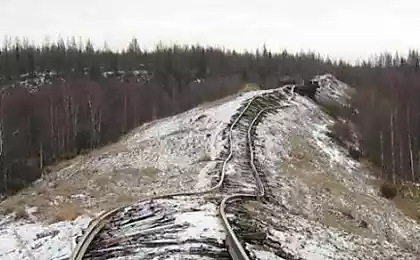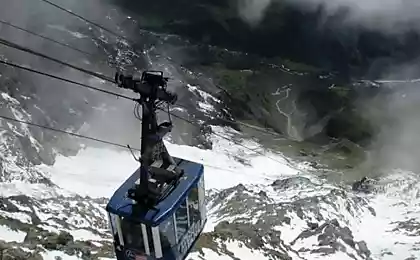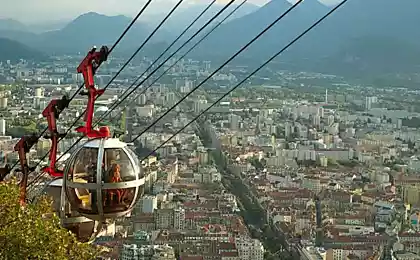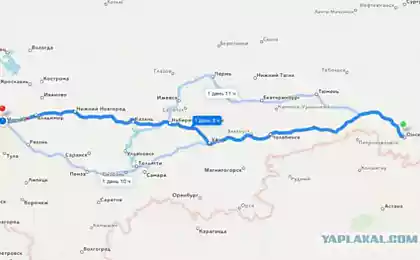2310
Dead Road ghost: the tragic story building
Immediately after the end of World War II had not yet risen from the destruction the Soviet Union embarked on an ambitious project. Force Main Directorate of prisoners NKVD camps in virtually uninhabited polar tundra large-scale construction of the Great Northern railway line, pipeline length of 1,400 kilometers, which was to connect European Russia with the Yenisei River delta. Just six years after the start of tens of thousands of construction workers promptly left the already half-built road.
As in the vast expanses of Western Siberia in the permafrost were buried thousands of lives and billions of Soviet rubles and why the project of the century abandoned unfinished ...
67 photos, and text.
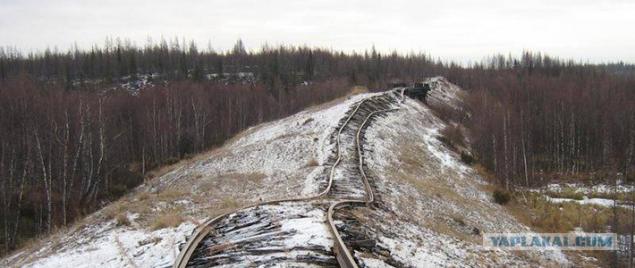
Even before the revolution of 1917, in the wake of the explosive development of railways in Russia, the engineers developed alternative routes to some extent duplicate the Great Siberian Route, which we now know as the Trans-Siberian Railway. Almost immediately after graduation in 1916 the construction of the railway between the European part of the empire, with its Pacific coast, enthusiasts presented a first draft of similar highway in the northern parts of the country, which, in turn, was to link the Murmansk, ice-free port in the Barents Sea, with the Ob, Surgut, the Yenisei, the northern shore of the lake and then go out to the Tatar Strait separating the mainland and Sakhalin.
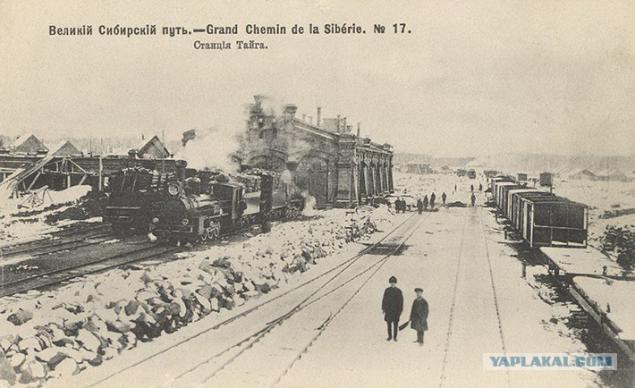
Of course, revolutionary disorder and the subsequent Civil War did not contribute to the practical realization of the colossal financial and labor project. However, in 1924 the future Salekhard-Igarka Railway, in official documents cited as the Great Northern railway track, was represented on the map-scheme of perspective development of the railways of the USSR. However, before the war, the government preferred to concentrate on the development of another Great Northern way - sea.

The beginning of the creation of trans-line in a broad sense can be considered as the construction of the Pechora railroad that connected the city of Kotlas of Arkhangelsk region with polar Vorkuta. Prisoners built the Main Directorate of the NKVD camps (Gulag) in 1937-1941, the road in wartime gained strategic importance, opening the Soviet metallurgy access to high-quality coking coal Pechora basin.
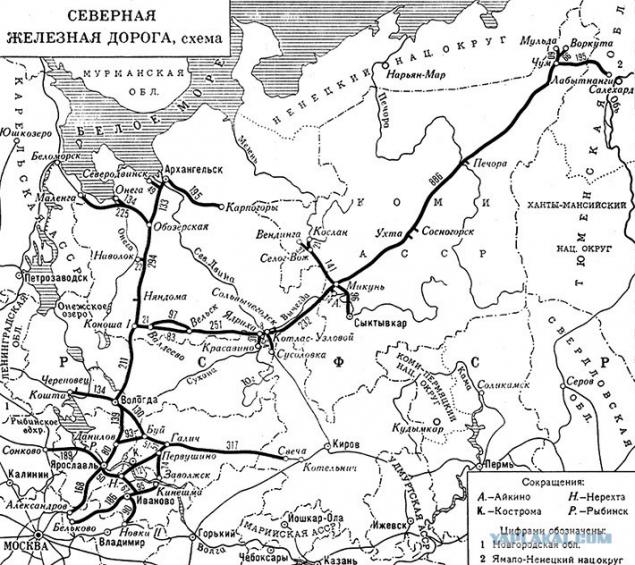
The first train on the new line, the end of December 1941.
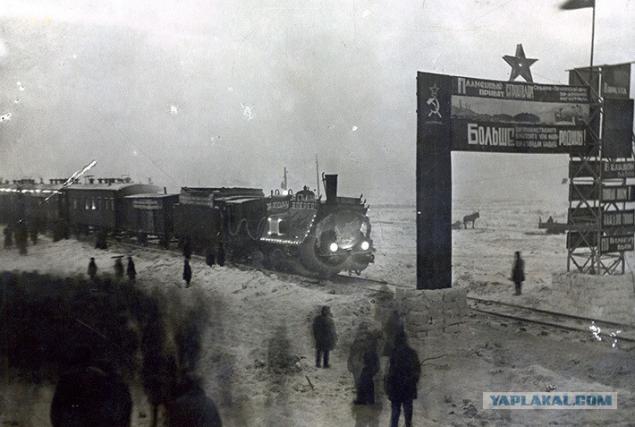
Documented restore the chain of events that led the builders to go along the Arctic Circle on the east, it is difficult, most of the documents are still classified. Nevertheless, almost all researchers are inclined to believe that the decision in 1947 to deploy the active construction of the railway in a very inconvenient for the area was personally Soviet leader, teacher and friend of all children, Stalin. He is even credited with the phrase, as if to put the beginning of the construction of the mighty: "We must take on the North, the North Siberia, undisguised, and the political situation is very dangerous."
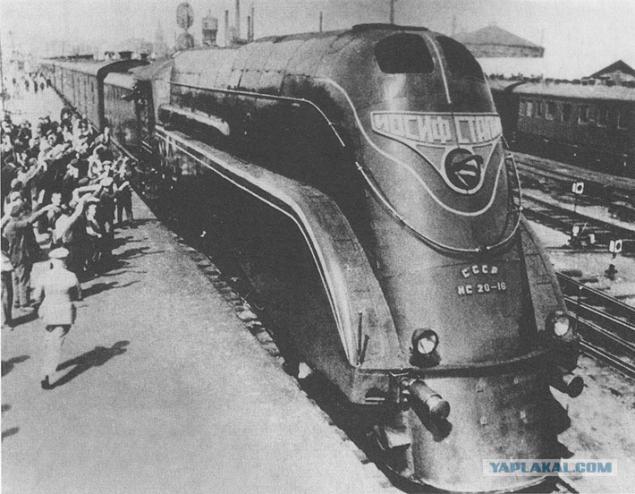
Vouch for the accuracy of quotes difficult, but the fact is the decision of the Council of Ministers of the USSR on April 22, 1947. According to the document, in the Ob Bay (Bay of the Kara Sea, which flows into the Ob) at Cape Stone was to be built a new major seaport with a residential village, and from the station Chum on the Pechora Railway (south of Vorkuta) them the railroad length in 500 kilometers. In the map by a red dot №1 marked the starting point of a promising line and point №2 - Cape Stone.
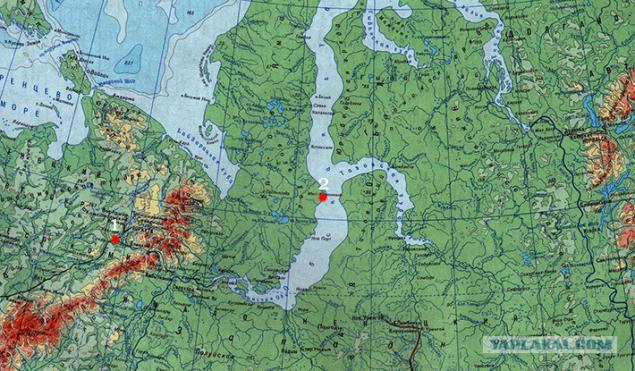
For the production of works already on April 28 in the framework of the Main Directorate of railway construction camps (GULZhDS, a division of the Gulag) were formed construction administration №501, the erection of the main branches of Veda and №502, engaged in the work of the seaport. The works were characteristic of the time and even more scrutiny accelerates the country's leadership pace. In December 1947, just eight months after the relevant decision, opened the labor movement on the 118-kilometer stretch of Chum - Sob, the road overcame the river valley Polar Urals - Sob patrol was already in the Tyumen region.
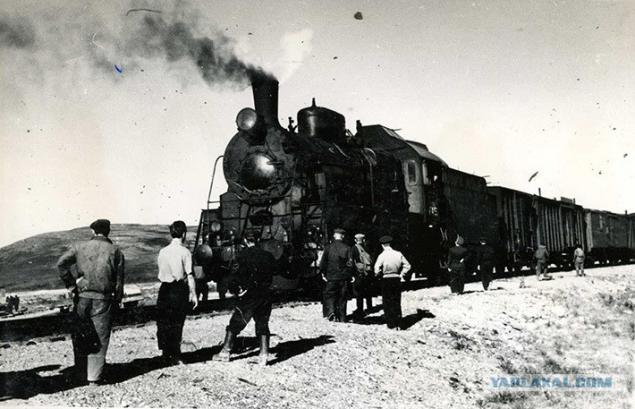
A year later, in December 1948, the builders have moved up to Labytnangi station on the left bank of the Ob, in front of Salekhard. However, at the same time suddenly it became clear that the Ob Bay, in the area of the Cape of stone, to create a new sea port is simply impossible. Conducted in parallel with the general construction works hydrographic studies have shown that the lip shallow, and even after dredging will still be unable to accept large ocean-going ships.
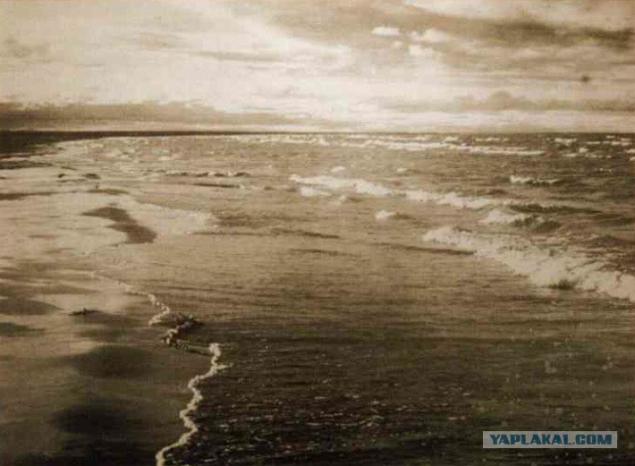
So, from April 1947 to December 1948, it was put into operation 196-kilometer trail Chum - Labytnangi. It is unclear what to do next, given the futility of the old northern "Ob" direction. January 29, 1949 after a meeting of Stalin, Beria and head GULZhDS "naphthalene" Frenkel came another decree of the Council of Ministers of the USSR, which defines the new location for the construction of the same "major sea lanes of the intermediate base." It was decided to move to the area of Igarka Turukhansk district of the Krasnoyarsk Territory, which is more than a thousand kilometers to the east, on the right bank of the Yenisei River, where a seaport operated from the late 1920s. So the Polar city looked in the early 1950s, at which time there were about 20 thousand. Man.
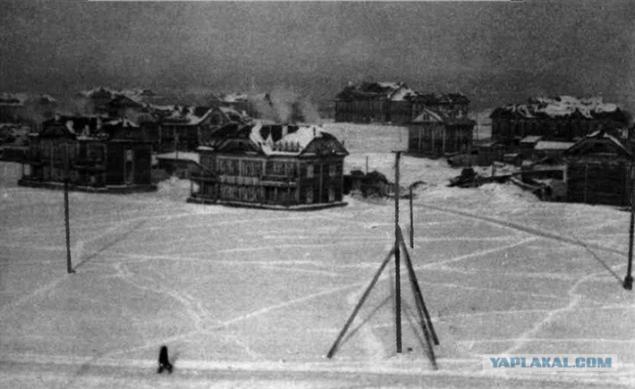
Instead of a relatively modest 500-kilometer road Chum - Cape Stone was born grand plan of building a really great way North Chum - Salekhard - Igarka total length of 1482 kilometers, of which 1286 had yet to build. The road is marked on the map Russia the red line (by clicking opens a larger image).
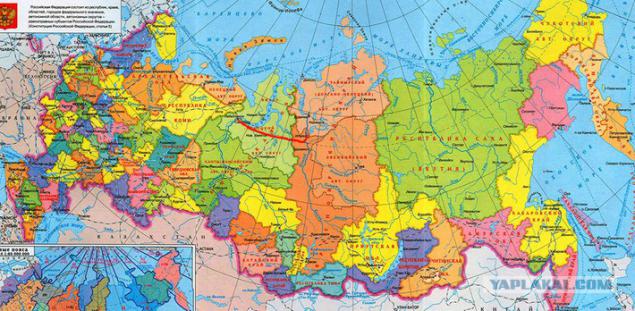
So, why the possible, perhaps only under Stalin tenacity man in the technologically most advanced 1940 began building a colossal longest railway in unpopulated polar tundra? On what rich deposits of oil and gas-mother-father contain the bowels of Western Siberia, Soviet geologists still anyone's guess. Probably, the main motivation of the Soviet leadership and the leader of the people in particular there was a desire to create a stand-Northern Sea Route, is not subject to seasonal freezing, with the release of a new head-sea Arctic port, remote from the borders of the country.
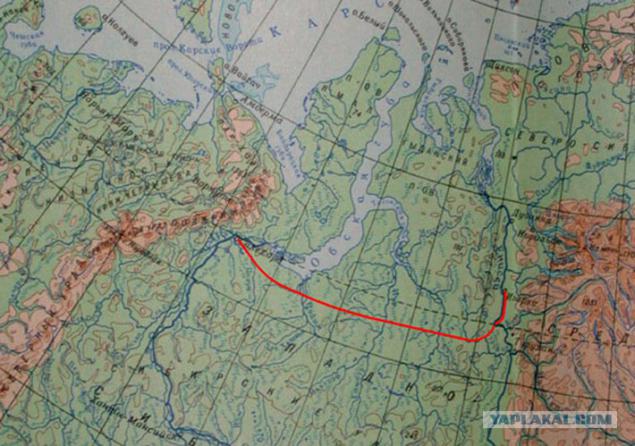
The events of World War II showed the vulnerability of the Soviet Arctic from outside attack. Certainly Stalin's memory was still fresh operation "Vunderland" ("Wonderland"), carried out Kriegsmarine summer of 1942 in the Kara Sea in order to prevent the passage of convoys allies from the east to Murmansk. German submarines torpedoed several Soviet vessels, and the heavy cruiser "Admiral Speer" even realized bombing Port Dickson, located at the exit lip of the Yenisei to the Arctic Ocean.
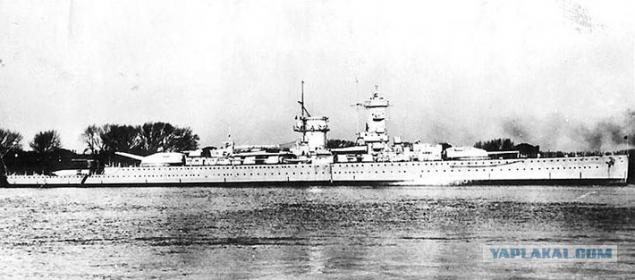
The new port in Igarka, which may well be viewed as a promising base of the Northern Fleet, looked in this sense, much more reliable. Moreover, in the immediate vicinity located Norilsk industrial region with its largest in the country and strategically important for the "defense" of nickel reserves. It is also using the new line could be connected to a single system of railways of the USSR.
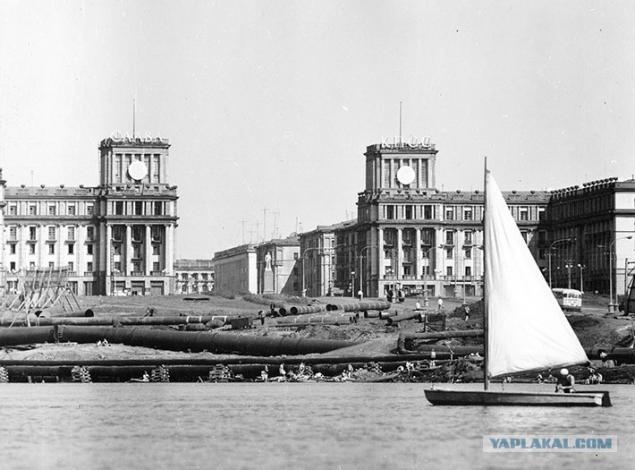
By the way, these seats were not strangers to Stalin. At one time, in the years 1914-1917, here, in the village of Kureyka Turukhansk province, 170 kilometers south of Igarka, he was exiled. After the war, surviving hut, where the future Generalissimo was living by the will of the king's bloody regime, covered by special pavilion, turning it into a museum, did not survive, however, the struggle against the cult of personality.
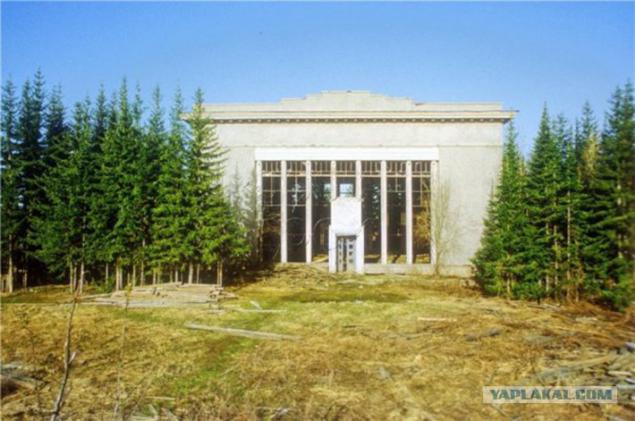
The second stage of the construction of trans-line. Office building №502, formerly occupied by the port at Cape Stone, are included in the same division №501 and instructed unified structure to engage in work on site Salekhard - Nadym - Pur River. At the same time formed in Igarka Construction Management №503, which was to pull the railway on the opposite, east side. Meet the two armies builders were on the river Pur. The literature documents and trans-line since often called "501-building" or "building-503" - depending on which of its station in question.
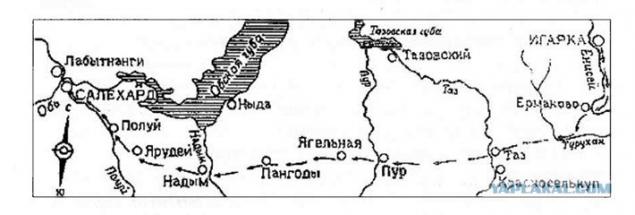
The main trouble was the trans-highway speed with which it was erected. It is difficult to say what caused these rush work and rush job. Other researchers are prone to conspiracy theories, even considering the construction of the railway as one of the stages of preparation of the Soviet Union and Stalin personally to World War III. Whatever it was, in the same January resolution of the Council of Ministers to define a new track line, and kept another fundamental point: it had to be erected on the "lightweight specifications." Operating trains in some areas planned to open in 1952, and the entire road was supposed to be ready by 1955.
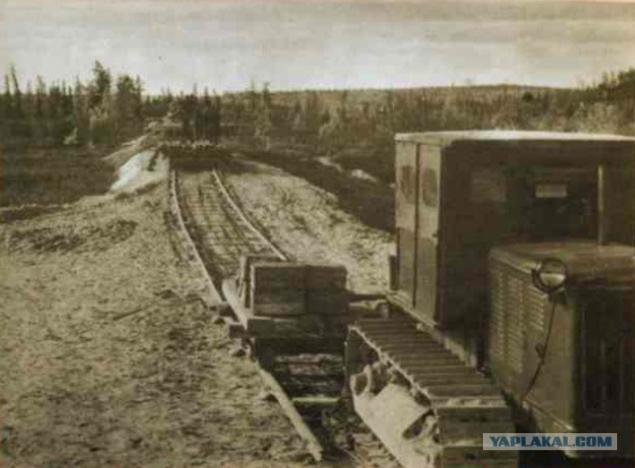
It was assumed that the new 1300 kilometer route runs parallel to the Arctic Circle, is a single-track travels every 9-14 km (total 106 trips) and stations 40-60 km (28 stations). The average speed of the train, with stops at the traveling assumed around 40 km / h, including acceleration and braking. Bandwidth - 6 pairs of trains per day. At stations Salekhard, Nadym, Pur, Taz, Ermakova and Igarka arranged main depots, stations Yarudey, Pangody, Kataral, Turuhan - negotiable.
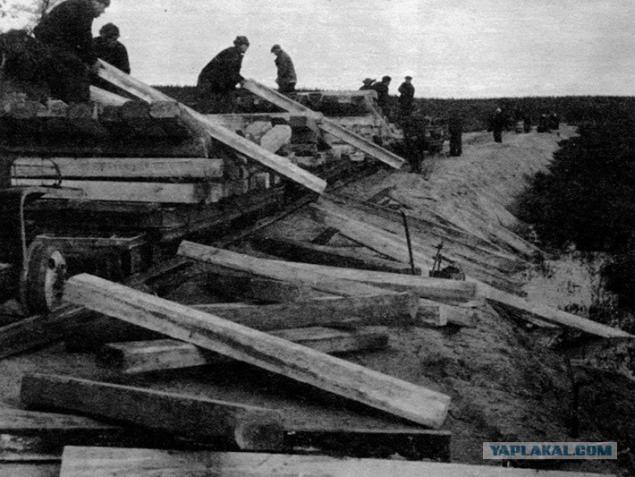
Work was carried out with virtually no design estimates mainly by the Main Directorate of railway construction camps. In total, this division of the Gulag, there were 290 thousand. Inmates, most of which was concentrated in the construction of 501 and 503, the most northern of the country.
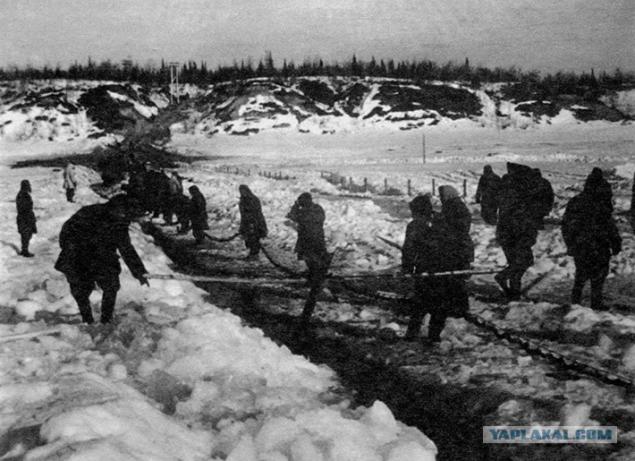
All along the highway special tractor train was paved winter road. Production of the two columns of controls GULZhDS placed along it. It was built mainly in the short summer season. To have started to construct a relatively low two-meter mound (mainly from imported stone and sand mixture), which is then stacked sleepers and rails. All work is carried out under conditions of extreme continental climate with harsh winters prolonged (up to eight months) and short, cold and rainy in summer and autumn. The average season builders have time to erect about 100 kilometers of railway.
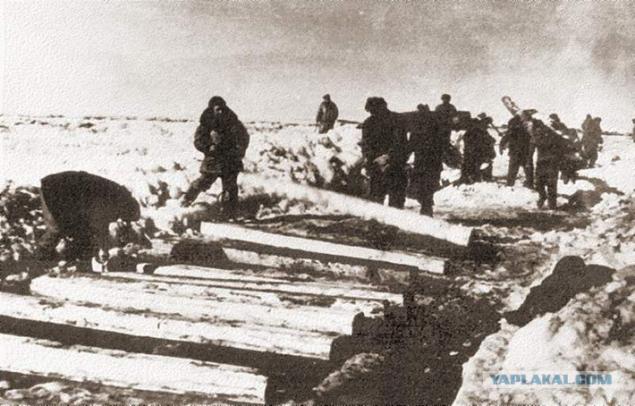
21
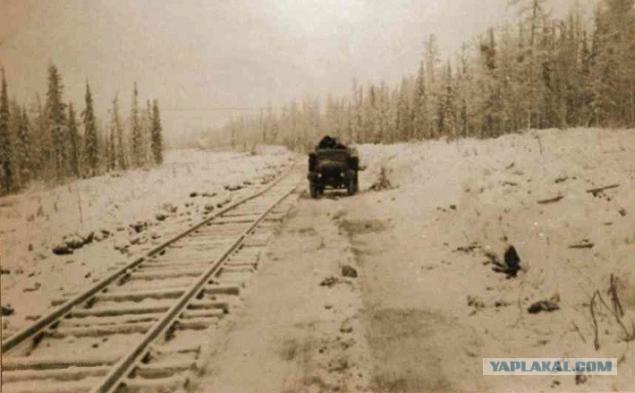
Salekhard-Igarka Railway was constructed under extreme conditions of permafrost. Technologies of the 1940s and the required speed of construction was not allowed to properly equip the railway as it is, for example, did the Chinese 70 years later with the Qinghai-Tibet Railway. After the onset of plus temperatures in Western Siberia began active melting of the upper soil layer and the permafrost under it, which led to regular and widespread deformation of the roadway and its engineering constructions. In fact, a significant part of the road made over the past seasons, with the advent of the new had to be reconstructed. Repairs embankment strengthening webs, bridges and other infrastructure lasted continuously every year.
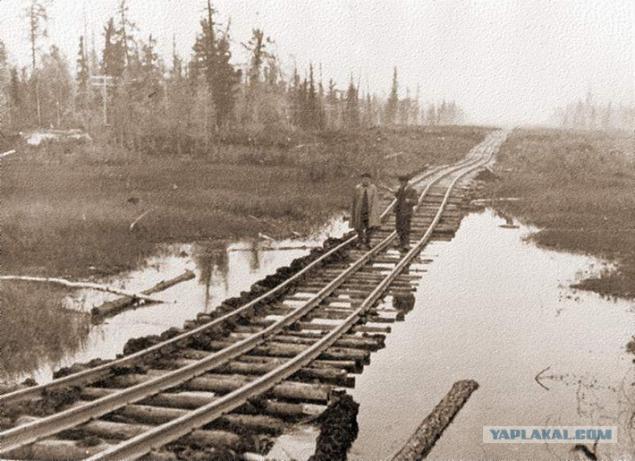
23
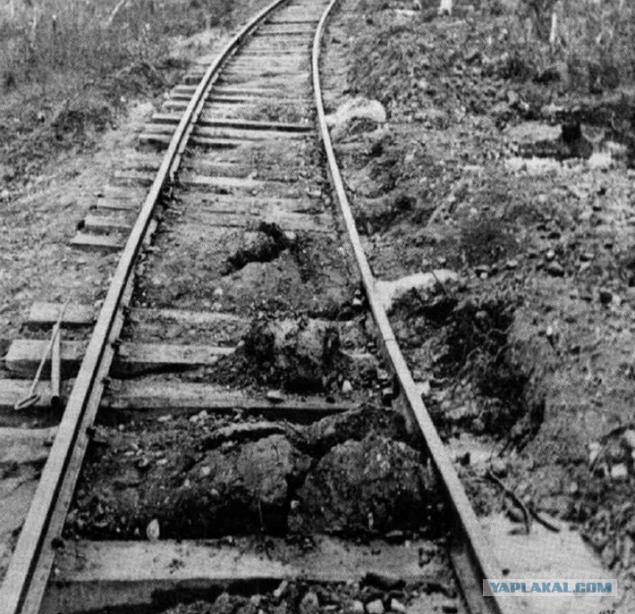
The climate did the work in the area of highway construction extremely difficult. In winter, the prisoners who worked in the construction of 501 and 503, covered with snow and frost tormented, assailed them in the summer rain, impassable mud, and the ever-present clouds of insects varying degrees of bloodthirstiness.
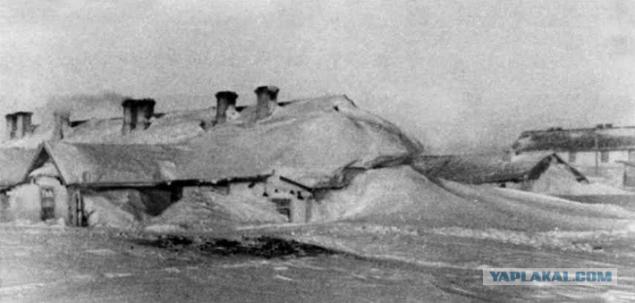
All along the route arranged small towns civilian construction workers, administration and prison camp at them. Local building materials in subarctic tundra was not enough, the forest in most cases imported from outside. Until it came to the construction of more or less of the capital housing, builders were forced to dwell in tents and dugouts. Gradually, they were replaced by the barracks themselves their future residents. The remains of many of the camps and towns is still regularly found along the transpolar.
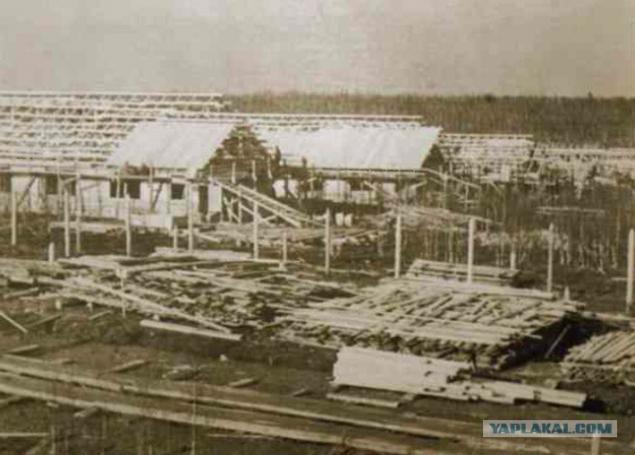
26
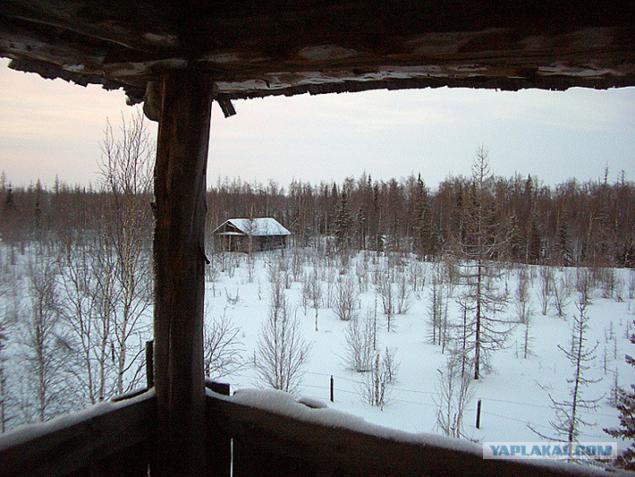
The average camp there was a barbed wire fenced perimeter of 500 × 500 meters from the watchtowers, one-story residential barracks, a dining room and a punishment cell. In one such education was located from 500 to 1000 people. For perimeter protection and home were civilian workers, shop, sauna, stores, Club.
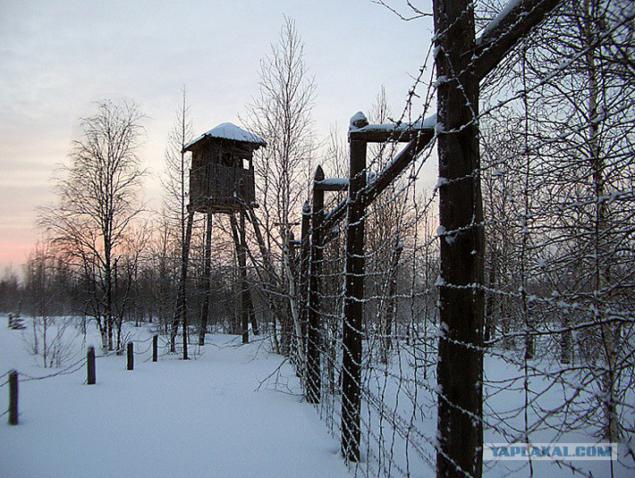
28
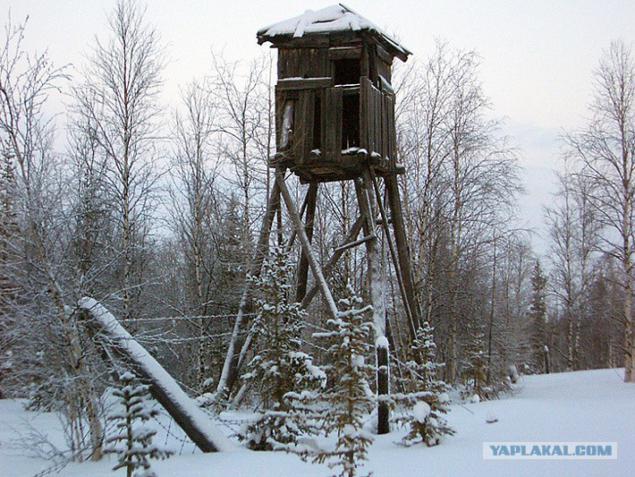
29
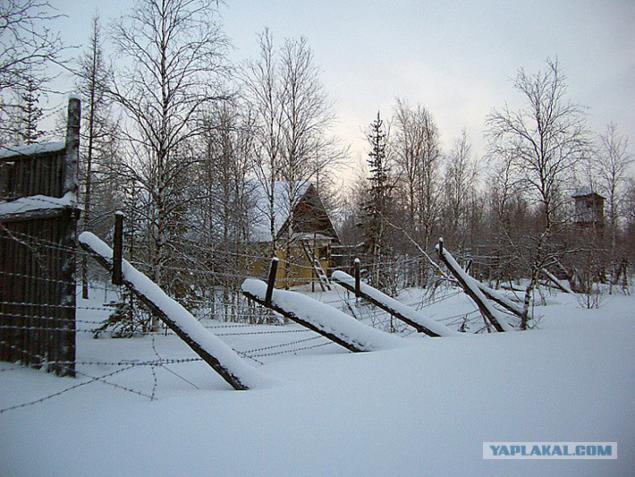
And looking ahead, and now looks Yermakovo village, one of the largest in construction (up to 15 thousand. Inhabitants), located on the left bank of the Yenisei River, near Igarka. It is actually the headquarters building №503 (the eastern half of the road), there is even time to build a power plant, depot, club, clinic, six stores, a hotel, ten-year school, baby house, which passed the children of imprisoned mothers, a restaurant and some other elements in the ordinary high ground, but this is a rare infrastructure.
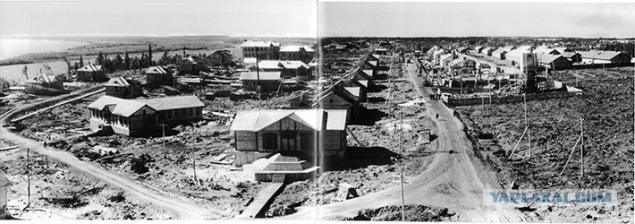
31
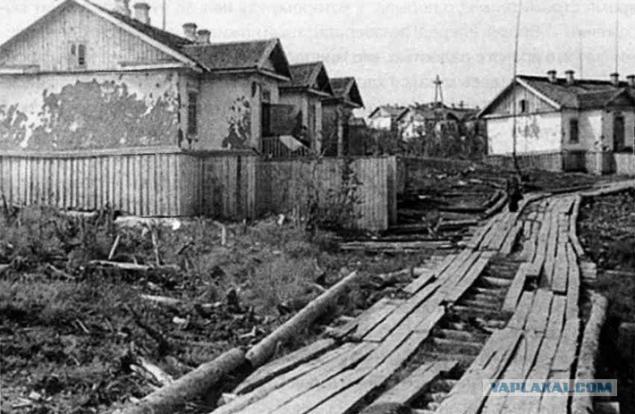
32
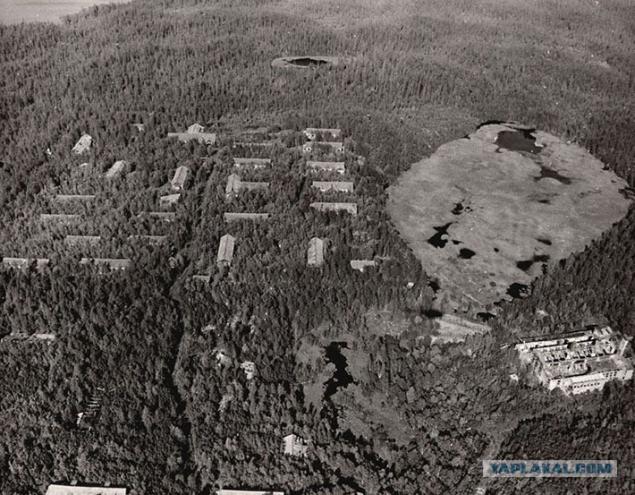
33
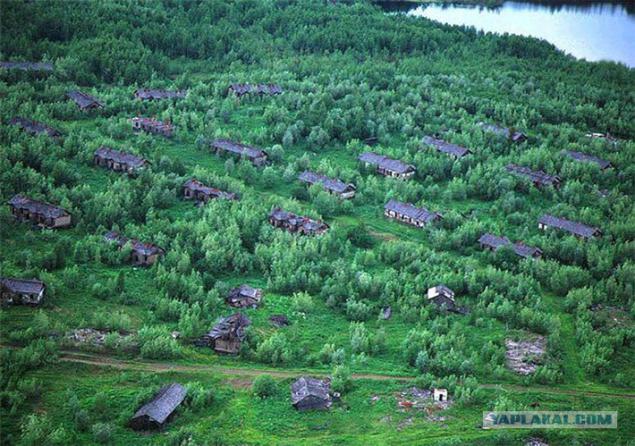
Compared to other camps of the Gulag in the construction of trans-it was relatively good. It is extremely difficult working conditions of prisoners were offset somewhat higher rate of supply. At the construction site, even worked as a traveling theater. The mortality rate, according to the memoirs of surviving eyewitnesses, was relatively small.
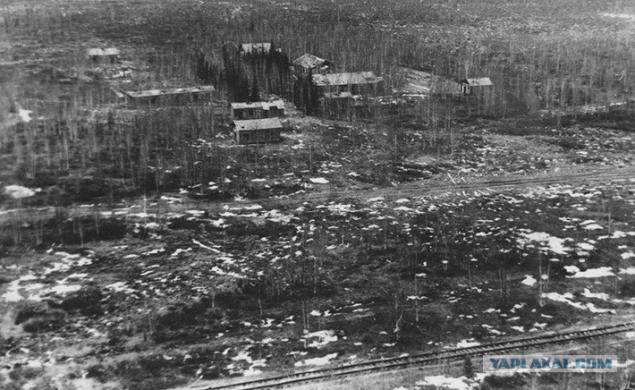
35
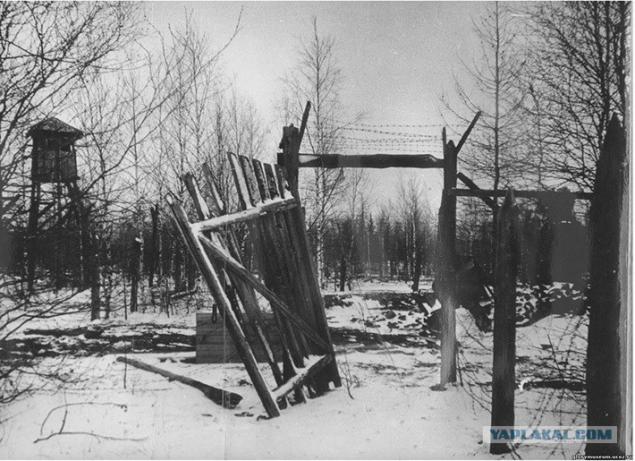
36

37
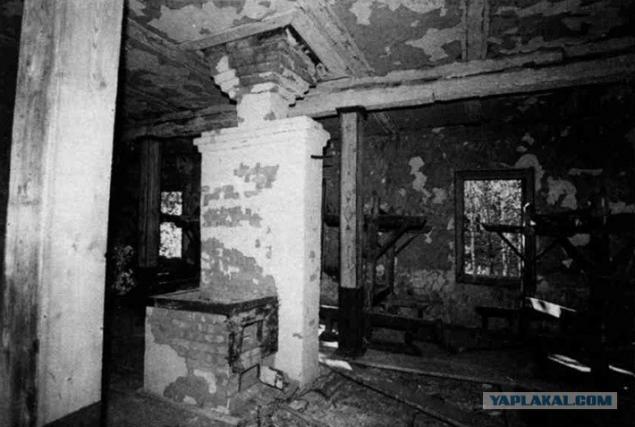
In addition to tens of thousands of people granted GULZhDS, there were many members of the Komsomol, and other enthusiasts who have arrived here, in fact, at the call of the heart and a corresponding voucher.
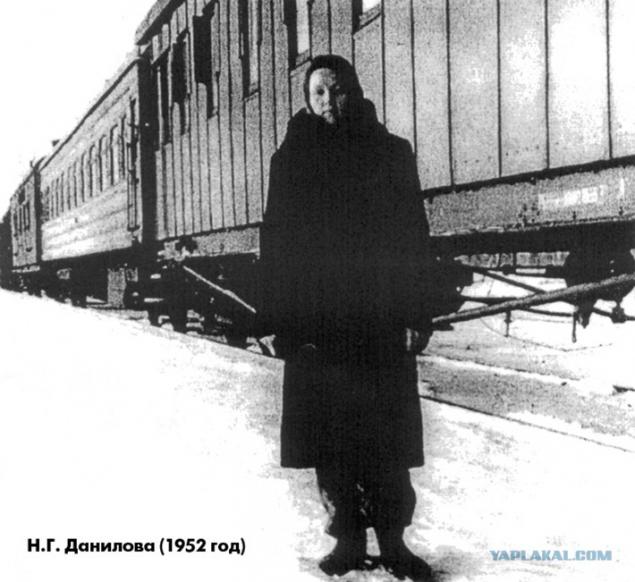
In addition to climate, work on the Salekhard - Igarka complicated by its distance from the mainland. Quality building materials "on site" virtually non-existent, they had to deliver from Salekhard of kilometers of roads already constructed or via the Northern Sea Route through Igarka.
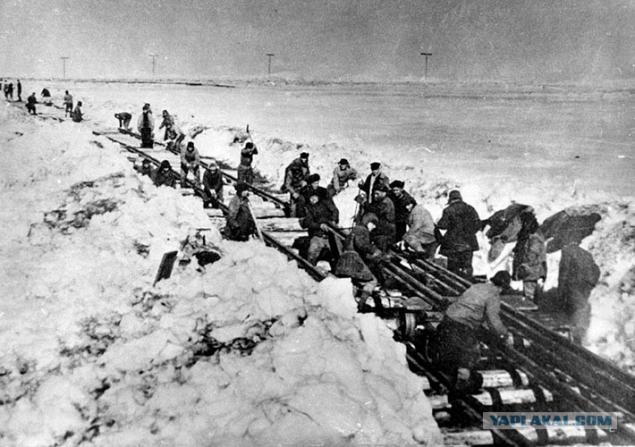
Small road crossed the river on a wooden bridge. The bridges over the large rivers and Barabaniha Makovskaya constructed a much more thorough: metal on concrete piers in length and 60 to 100 meters, respectively. However, deformation and fracture due to melting and subsequent freezing of the soil has not escaped any of the structures built by "lite specifications."
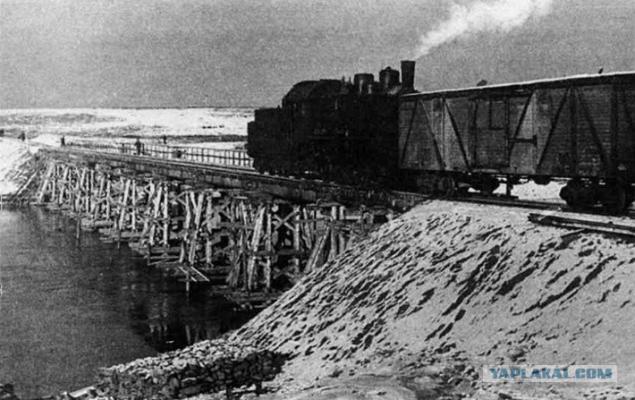
41
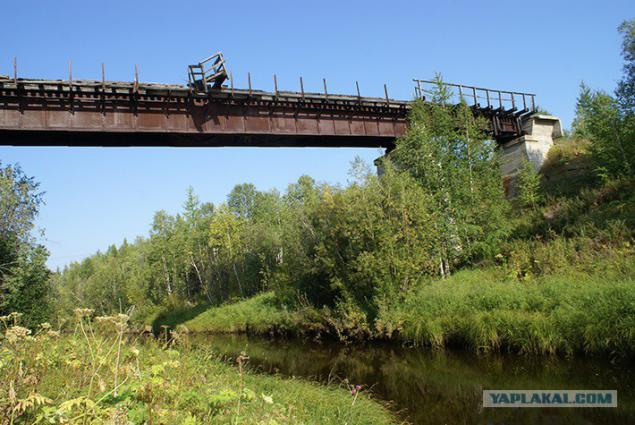
42

Through the great Siberian rivers Ob and Yenisei bridges were not built at all. In the summer of used special ferries were directed winter ice crossing.
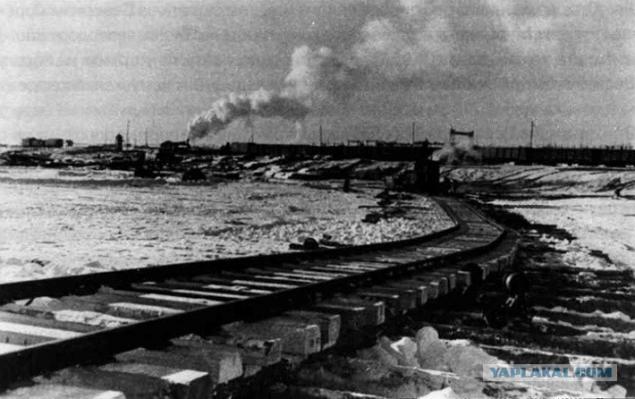
Rails, of course, also brought from the mainland. Total researchers found on the track of 16 different species, including the pre-revolutionary and a trophy.
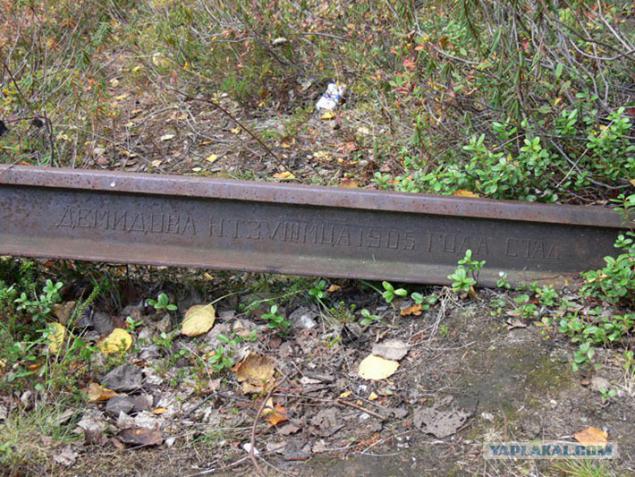
In August 1952, as planned, have opened the labor movement on the site of the Salekhard - Nadym, by March next year between the settlements have even walked a passenger train. However, its speed (and the speed of freight trains, used to supply the building) because of the extremely low quality of the railway line was low and averaged 15 km / h, not even close to reaching the standard indicators. But even in such a situation gatherings derailed trains were frequent and widespread.
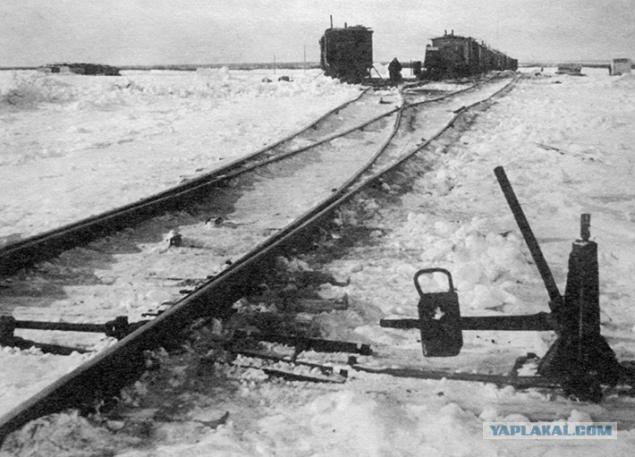
By the spring of 1953 in total was built around 700 kilometers of the Great Northern ways, more than half of the entire length of the highway, but the March 25, 1953 release of the next Council of Ministers of the USSR, according to which the construction of the Salekhard - Igarka stopped. Start immediately and rapid evacuation of the workforce. By most estimates, a few months between the rivers of the Ob and Yenisei were evacuated to the mainland to 100 thousand. Man.
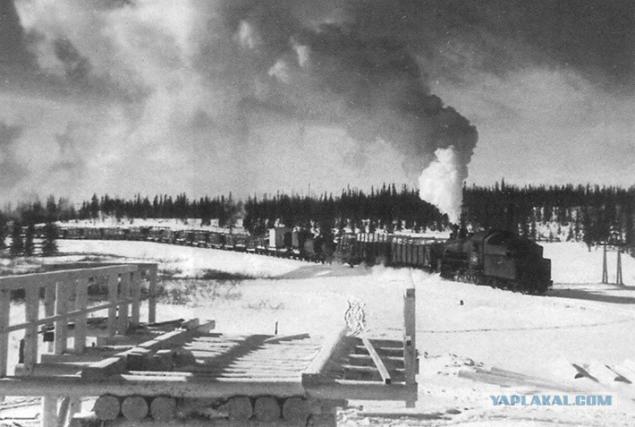
It explains this voluntarist first sight very simple solution: March 5, 1953 when Stalin died, and with him was at first seems to be conserved, and then finally abandoned and the Salekhard-Igarka Railway. The railway is being built at an unprecedented pace in extreme weather conditions, it turned out to be the country does not need.
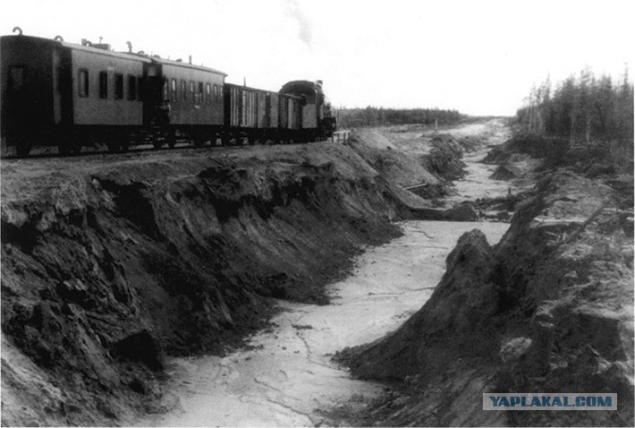
Total land in the West Siberian marshes and subarctic tundra was literally buried 3, 2 billion rubles, so need to raise from the ruins of the Soviet Union. This amount accounted for 12, 5% of capital investments in the USSR railway construction over the five-year period 1946-1950 years and about 2% of all capital investments of the USSR during the same period. How many lives have taken 501 and 503 construction projects, just not installed.
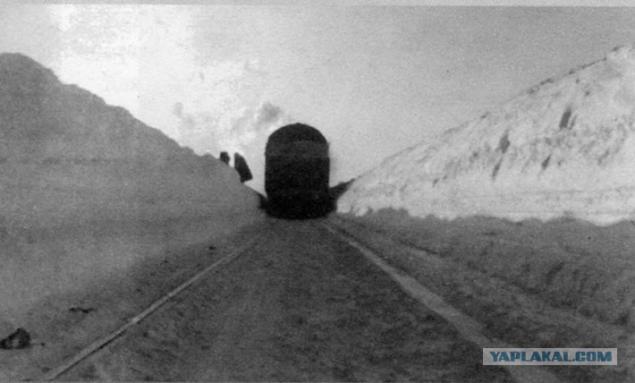
50
51
52
54
55
56
57
60
61
64
65
66
source
Source:
As in the vast expanses of Western Siberia in the permafrost were buried thousands of lives and billions of Soviet rubles and why the project of the century abandoned unfinished ...
67 photos, and text.

Even before the revolution of 1917, in the wake of the explosive development of railways in Russia, the engineers developed alternative routes to some extent duplicate the Great Siberian Route, which we now know as the Trans-Siberian Railway. Almost immediately after graduation in 1916 the construction of the railway between the European part of the empire, with its Pacific coast, enthusiasts presented a first draft of similar highway in the northern parts of the country, which, in turn, was to link the Murmansk, ice-free port in the Barents Sea, with the Ob, Surgut, the Yenisei, the northern shore of the lake and then go out to the Tatar Strait separating the mainland and Sakhalin.

Of course, revolutionary disorder and the subsequent Civil War did not contribute to the practical realization of the colossal financial and labor project. However, in 1924 the future Salekhard-Igarka Railway, in official documents cited as the Great Northern railway track, was represented on the map-scheme of perspective development of the railways of the USSR. However, before the war, the government preferred to concentrate on the development of another Great Northern way - sea.

The beginning of the creation of trans-line in a broad sense can be considered as the construction of the Pechora railroad that connected the city of Kotlas of Arkhangelsk region with polar Vorkuta. Prisoners built the Main Directorate of the NKVD camps (Gulag) in 1937-1941, the road in wartime gained strategic importance, opening the Soviet metallurgy access to high-quality coking coal Pechora basin.

The first train on the new line, the end of December 1941.

Documented restore the chain of events that led the builders to go along the Arctic Circle on the east, it is difficult, most of the documents are still classified. Nevertheless, almost all researchers are inclined to believe that the decision in 1947 to deploy the active construction of the railway in a very inconvenient for the area was personally Soviet leader, teacher and friend of all children, Stalin. He is even credited with the phrase, as if to put the beginning of the construction of the mighty: "We must take on the North, the North Siberia, undisguised, and the political situation is very dangerous."

Vouch for the accuracy of quotes difficult, but the fact is the decision of the Council of Ministers of the USSR on April 22, 1947. According to the document, in the Ob Bay (Bay of the Kara Sea, which flows into the Ob) at Cape Stone was to be built a new major seaport with a residential village, and from the station Chum on the Pechora Railway (south of Vorkuta) them the railroad length in 500 kilometers. In the map by a red dot №1 marked the starting point of a promising line and point №2 - Cape Stone.

For the production of works already on April 28 in the framework of the Main Directorate of railway construction camps (GULZhDS, a division of the Gulag) were formed construction administration №501, the erection of the main branches of Veda and №502, engaged in the work of the seaport. The works were characteristic of the time and even more scrutiny accelerates the country's leadership pace. In December 1947, just eight months after the relevant decision, opened the labor movement on the 118-kilometer stretch of Chum - Sob, the road overcame the river valley Polar Urals - Sob patrol was already in the Tyumen region.

A year later, in December 1948, the builders have moved up to Labytnangi station on the left bank of the Ob, in front of Salekhard. However, at the same time suddenly it became clear that the Ob Bay, in the area of the Cape of stone, to create a new sea port is simply impossible. Conducted in parallel with the general construction works hydrographic studies have shown that the lip shallow, and even after dredging will still be unable to accept large ocean-going ships.

So, from April 1947 to December 1948, it was put into operation 196-kilometer trail Chum - Labytnangi. It is unclear what to do next, given the futility of the old northern "Ob" direction. January 29, 1949 after a meeting of Stalin, Beria and head GULZhDS "naphthalene" Frenkel came another decree of the Council of Ministers of the USSR, which defines the new location for the construction of the same "major sea lanes of the intermediate base." It was decided to move to the area of Igarka Turukhansk district of the Krasnoyarsk Territory, which is more than a thousand kilometers to the east, on the right bank of the Yenisei River, where a seaport operated from the late 1920s. So the Polar city looked in the early 1950s, at which time there were about 20 thousand. Man.

Instead of a relatively modest 500-kilometer road Chum - Cape Stone was born grand plan of building a really great way North Chum - Salekhard - Igarka total length of 1482 kilometers, of which 1286 had yet to build. The road is marked on the map Russia the red line (by clicking opens a larger image).

So, why the possible, perhaps only under Stalin tenacity man in the technologically most advanced 1940 began building a colossal longest railway in unpopulated polar tundra? On what rich deposits of oil and gas-mother-father contain the bowels of Western Siberia, Soviet geologists still anyone's guess. Probably, the main motivation of the Soviet leadership and the leader of the people in particular there was a desire to create a stand-Northern Sea Route, is not subject to seasonal freezing, with the release of a new head-sea Arctic port, remote from the borders of the country.

The events of World War II showed the vulnerability of the Soviet Arctic from outside attack. Certainly Stalin's memory was still fresh operation "Vunderland" ("Wonderland"), carried out Kriegsmarine summer of 1942 in the Kara Sea in order to prevent the passage of convoys allies from the east to Murmansk. German submarines torpedoed several Soviet vessels, and the heavy cruiser "Admiral Speer" even realized bombing Port Dickson, located at the exit lip of the Yenisei to the Arctic Ocean.

The new port in Igarka, which may well be viewed as a promising base of the Northern Fleet, looked in this sense, much more reliable. Moreover, in the immediate vicinity located Norilsk industrial region with its largest in the country and strategically important for the "defense" of nickel reserves. It is also using the new line could be connected to a single system of railways of the USSR.

By the way, these seats were not strangers to Stalin. At one time, in the years 1914-1917, here, in the village of Kureyka Turukhansk province, 170 kilometers south of Igarka, he was exiled. After the war, surviving hut, where the future Generalissimo was living by the will of the king's bloody regime, covered by special pavilion, turning it into a museum, did not survive, however, the struggle against the cult of personality.

The second stage of the construction of trans-line. Office building №502, formerly occupied by the port at Cape Stone, are included in the same division №501 and instructed unified structure to engage in work on site Salekhard - Nadym - Pur River. At the same time formed in Igarka Construction Management №503, which was to pull the railway on the opposite, east side. Meet the two armies builders were on the river Pur. The literature documents and trans-line since often called "501-building" or "building-503" - depending on which of its station in question.

The main trouble was the trans-highway speed with which it was erected. It is difficult to say what caused these rush work and rush job. Other researchers are prone to conspiracy theories, even considering the construction of the railway as one of the stages of preparation of the Soviet Union and Stalin personally to World War III. Whatever it was, in the same January resolution of the Council of Ministers to define a new track line, and kept another fundamental point: it had to be erected on the "lightweight specifications." Operating trains in some areas planned to open in 1952, and the entire road was supposed to be ready by 1955.

It was assumed that the new 1300 kilometer route runs parallel to the Arctic Circle, is a single-track travels every 9-14 km (total 106 trips) and stations 40-60 km (28 stations). The average speed of the train, with stops at the traveling assumed around 40 km / h, including acceleration and braking. Bandwidth - 6 pairs of trains per day. At stations Salekhard, Nadym, Pur, Taz, Ermakova and Igarka arranged main depots, stations Yarudey, Pangody, Kataral, Turuhan - negotiable.

Work was carried out with virtually no design estimates mainly by the Main Directorate of railway construction camps. In total, this division of the Gulag, there were 290 thousand. Inmates, most of which was concentrated in the construction of 501 and 503, the most northern of the country.

All along the highway special tractor train was paved winter road. Production of the two columns of controls GULZhDS placed along it. It was built mainly in the short summer season. To have started to construct a relatively low two-meter mound (mainly from imported stone and sand mixture), which is then stacked sleepers and rails. All work is carried out under conditions of extreme continental climate with harsh winters prolonged (up to eight months) and short, cold and rainy in summer and autumn. The average season builders have time to erect about 100 kilometers of railway.

21

Salekhard-Igarka Railway was constructed under extreme conditions of permafrost. Technologies of the 1940s and the required speed of construction was not allowed to properly equip the railway as it is, for example, did the Chinese 70 years later with the Qinghai-Tibet Railway. After the onset of plus temperatures in Western Siberia began active melting of the upper soil layer and the permafrost under it, which led to regular and widespread deformation of the roadway and its engineering constructions. In fact, a significant part of the road made over the past seasons, with the advent of the new had to be reconstructed. Repairs embankment strengthening webs, bridges and other infrastructure lasted continuously every year.

23

The climate did the work in the area of highway construction extremely difficult. In winter, the prisoners who worked in the construction of 501 and 503, covered with snow and frost tormented, assailed them in the summer rain, impassable mud, and the ever-present clouds of insects varying degrees of bloodthirstiness.

All along the route arranged small towns civilian construction workers, administration and prison camp at them. Local building materials in subarctic tundra was not enough, the forest in most cases imported from outside. Until it came to the construction of more or less of the capital housing, builders were forced to dwell in tents and dugouts. Gradually, they were replaced by the barracks themselves their future residents. The remains of many of the camps and towns is still regularly found along the transpolar.

26

The average camp there was a barbed wire fenced perimeter of 500 × 500 meters from the watchtowers, one-story residential barracks, a dining room and a punishment cell. In one such education was located from 500 to 1000 people. For perimeter protection and home were civilian workers, shop, sauna, stores, Club.

28

29

And looking ahead, and now looks Yermakovo village, one of the largest in construction (up to 15 thousand. Inhabitants), located on the left bank of the Yenisei River, near Igarka. It is actually the headquarters building №503 (the eastern half of the road), there is even time to build a power plant, depot, club, clinic, six stores, a hotel, ten-year school, baby house, which passed the children of imprisoned mothers, a restaurant and some other elements in the ordinary high ground, but this is a rare infrastructure.

31

32

33

Compared to other camps of the Gulag in the construction of trans-it was relatively good. It is extremely difficult working conditions of prisoners were offset somewhat higher rate of supply. At the construction site, even worked as a traveling theater. The mortality rate, according to the memoirs of surviving eyewitnesses, was relatively small.

35

36

37

In addition to tens of thousands of people granted GULZhDS, there were many members of the Komsomol, and other enthusiasts who have arrived here, in fact, at the call of the heart and a corresponding voucher.

In addition to climate, work on the Salekhard - Igarka complicated by its distance from the mainland. Quality building materials "on site" virtually non-existent, they had to deliver from Salekhard of kilometers of roads already constructed or via the Northern Sea Route through Igarka.

Small road crossed the river on a wooden bridge. The bridges over the large rivers and Barabaniha Makovskaya constructed a much more thorough: metal on concrete piers in length and 60 to 100 meters, respectively. However, deformation and fracture due to melting and subsequent freezing of the soil has not escaped any of the structures built by "lite specifications."

41

42

Through the great Siberian rivers Ob and Yenisei bridges were not built at all. In the summer of used special ferries were directed winter ice crossing.

Rails, of course, also brought from the mainland. Total researchers found on the track of 16 different species, including the pre-revolutionary and a trophy.

In August 1952, as planned, have opened the labor movement on the site of the Salekhard - Nadym, by March next year between the settlements have even walked a passenger train. However, its speed (and the speed of freight trains, used to supply the building) because of the extremely low quality of the railway line was low and averaged 15 km / h, not even close to reaching the standard indicators. But even in such a situation gatherings derailed trains were frequent and widespread.

By the spring of 1953 in total was built around 700 kilometers of the Great Northern ways, more than half of the entire length of the highway, but the March 25, 1953 release of the next Council of Ministers of the USSR, according to which the construction of the Salekhard - Igarka stopped. Start immediately and rapid evacuation of the workforce. By most estimates, a few months between the rivers of the Ob and Yenisei were evacuated to the mainland to 100 thousand. Man.

It explains this voluntarist first sight very simple solution: March 5, 1953 when Stalin died, and with him was at first seems to be conserved, and then finally abandoned and the Salekhard-Igarka Railway. The railway is being built at an unprecedented pace in extreme weather conditions, it turned out to be the country does not need.

Total land in the West Siberian marshes and subarctic tundra was literally buried 3, 2 billion rubles, so need to raise from the ruins of the Soviet Union. This amount accounted for 12, 5% of capital investments in the USSR railway construction over the five-year period 1946-1950 years and about 2% of all capital investments of the USSR during the same period. How many lives have taken 501 and 503 construction projects, just not installed.

50
51
52
54
55
56
57
60
61
64
65
66
source
Source:






